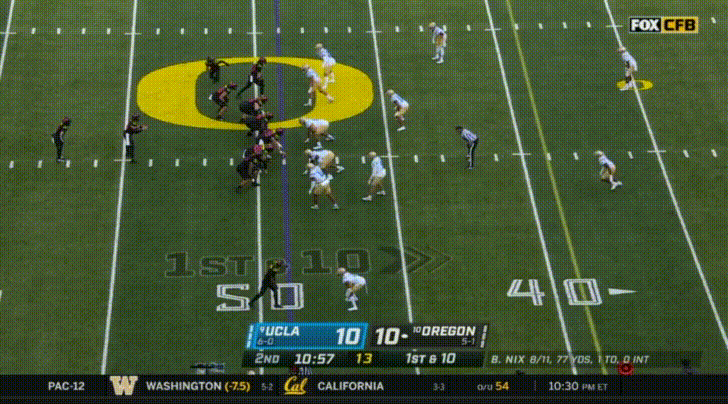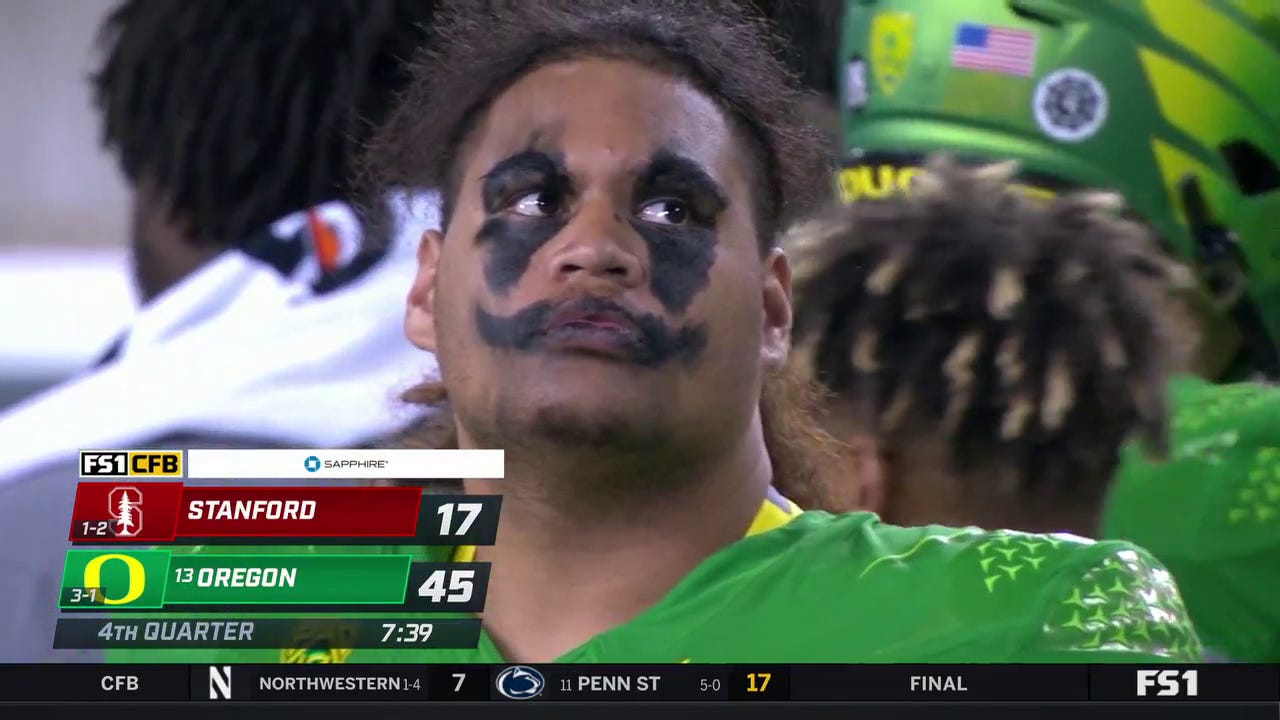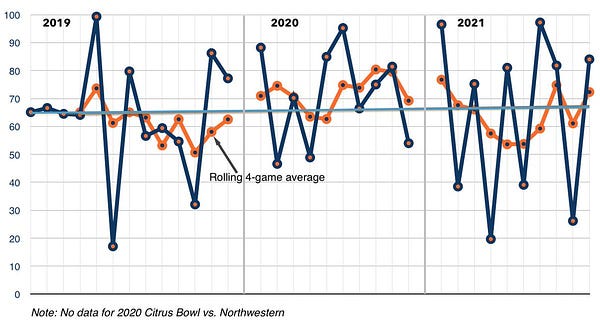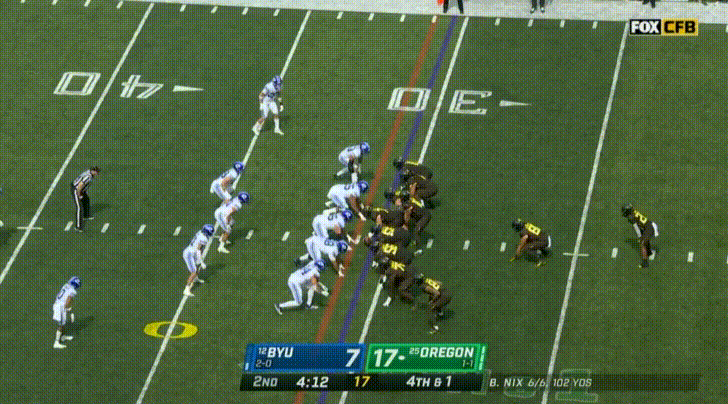Oregon Football Offensive Preview
Oregon has the best offense in the Pac-12. What could possibly go wrong for the Bears?
After the Bears stumbled through the softer part of the schedule, it became a lot harder to stay optimistic for the remainder of the season: top teams in the Pac-12 which all present difficult stylistic matchups for Cal (Oregon, USC, UCLA), even if Cal was firing on all cylinders (picture a well-maintained Toyota Tercel). Instead of presenting a team’s strengths and weaknesses, I now feel like I’m just documenting the different ways the opponents will beat Cal. Sigh.
Up first: Oregon. Dan Lanning may have been the defensive coordinator for one of college football’s all-time great defenses (2021 Georgia), but it’s the Oregon offense that’s turning heads. They currently lead the Pac-12 in both yards per game and points per game, and they’re 5th in the FBS in rushing offense (and 3 of the 4 teams above them are service academies that run the triple option). They lead the FBS in fewest sacks allowed, with just one sack in their 7 games. And this is the sack:
That is to say, this is probably one of the best offensive lines in college football. They pass protect extremely well, giving their quarterback plenty of time to throw so that he can remain calm in the pocket. They also open huge lanes for their running backs, hence one of the top rushing offenses in the FBS.
Cal has a battered defensive line facing off against one of the best offensive lines in college football. And as good as the Cal secondary has been under Wilcox, they typically have their worst games against dual-threat quarterbacks, as the threat of the run typically opens up large gaps in the defense down the field. Last week I mentioned how Washington had a good offense but Cal’s defense matched up well against them, and was probably their best shot at an upset. Well, Cal’s defense does not at all match up well with Oregon, and I really struggle to imagine any possible way this game might go well for Cal.
So on that depressing note, let’s take a closer look at the offensive units.
Offensive line
As you may or may not know, I take highlight clips as I watch the games. This means that I don’t really have anything I’m looking for in particular, I’m just trying to capture any moment I think might be significant, but it’s a lot easier to determine what “significant” is in hindsight. That is to say, if I had any foresight, I would have been taking offensive linemen highlights, because this is one of the best offensive lines in college football. It’s usually not one particular play that stands out, but how the unit performs as an aggregate: they rarely miss assignments, they usually win matchups, and they consistently get to their secondary blocking assignments on runs to open up huge lanes for their running backs to run through.
The most obvious display of their dominance, though, is their performance in short yardage situations. If it’s 3rd and short or 4th and short, you know Oregon is going to run the ball, and you’re not going to be able to stop them. The offensive line consistently gets a huge push at the line to convert in short yardage situations:

How good are they? Oregon is 3rd in the FBS in 4th down conversion percentage with 12/13 conversions (92.3%). That includes converting 2/3 4th downs against #1 Georgia. The only teams higher? AP rank #1 Georgia (6/6), and AP rank #2 Ohio State (9/9). Only the two best teams in the country can do it better than Oregon.
If you’re a fan of offensive line play, keep an eye on the right tackle, Malaesala Aumavae-Laulu. Like the rest of the offensive line, he’s a great pass blocker, but I find that where he goes on run plays is a pretty good indication of where the running back will follow.
Quarterback
Oregon is led by Auburn transfer and former 5-star quarterback, Bo Nix. Nix is a very polarizing quarterback, because his play Auburn was about as inconsistent as it gets:
As a former 5-star recruit, it should come as no surprise that Nix has all the tools to succeed: a big arm, the ability to run the ball well, a ton of athleticism, and so on. The biggest knock against him at Auburn was his tendency to play “hero ball”: with a subpar offensive line and constant coaching turnover, Nix took it upon himself to try to make things happen. As you can see from the graph above, that can be pretty hit or miss. As a true freshman in 2019, Nix led Auburn to a victory over a Justin Herbert-led Oregon team, although I remember many of those same issues: forcing throws for interceptions. Pressure would get to him, he’d scramble out of the pocket, and throw across his body on the run for an inaccurate and often dangerous pass.
Of course, Oregon happened to be the perfect landing spot for him. Behind a stellar offensive line, he’s rarely pressured, which gives him plenty of time to survey the field and make a good decision. The few times he is pressured, he does a good job of escaping the pocket and using his legs to pick up yards, and now stays calm enough under pressure to make a good decision with the throw when he has a pass rusher bearing down on him (and he only needs to do it a few times per game, instead of all game like he did at Auburn).
The first thing that stands out about him is his accuracy. When he has time, he’s shown some excellent placement on throws to hit his receivers in stride:
Nix loses a bit of his mechanics when throwing on the move, but he likes to roll out of the pocket to make throws:
Nix has also shown NFL arm strength on his throws down the field, not letting his passes float in the air for as long as some of the other quarterbacks in the conference.
Nix is very clearly a dual-threat quarterback, and possesses significant speed as a runner:
Consequently, Nix must always be accounted for in the read-option game:
His ability as a dual-threat quarterback mean that defense have to take him seriously both running and throwing the ball, allowing him to find his way to the endzone even when there are defenders in place to stop him:
Nix has 8 of Oregon’s 20 rushing touchdowns so far this season, twice as many as any other Oregon player. This means that Nix is frequently calling his own number in the red zone. (For the record, the most rushing TDs by a quarterback in the FBS is 9).
As a result of his experience at Auburn, Nix has the ability to improvise, and his running ability frequently puts defenses in a bind. In the following play, he dodges one of the best pass rushers in the conference, and the threat of him running the ball opens up his checkdown on the play:

Watch as the entire defense flows with Nix, before he uses his considerable arm strength to throw it back across the field to an open receiver:

Because Oregon runs the ball so well (and I mean the running backs too), defenses will commit defenders to stop the run, which often leaves their corners in man coverage. Here, the threat of the run (on the play action) sucks the defense in, before Nix launches it deep to his deep threat receiver:

That is to say, the Oregon offense puts defenses in a real bind, and that probably explains why Oregon is averaging 42.4 points per game.
Although Bo Nix is looking much better than he did in his Auburn days, he’s still not immune to “hero ball.” For example, here he underthrows his receiver in double-coverage:

And again, even with a receiver wide open on a crossing route right in front of him, he takes an unnecessary risk making a very ill-advised throw swinging for the fences despite already being up by 4 touchdowns shortly after halftime:

Nix has 17 passing touchdowns to just 3 interceptions, but he has definitely thrown a number of “interception-worthy” throws.
Oregon usually doesn’t punt the ball until the 4th quarter, but just in case Cal gets a stop early, it’s worth noting the following Bo Nix talent. that we probably won’t see at all:
At this point in his career, QB Bo Nix is a known quantity. He’s got a big arm, he can throw on the run, he has excellent accuracy on his short- to intermediate-range throws, he can run the ball, he can use the threat of the run to improvise plays, and he can even punt the ball. He can run the ball to set up the pass, and he can pass the ball to set up the run. Most of his mistakes are fixable with good coaching, which is why I expect an NFL team to take a flyer on him in the early rounds of the NFL Draft.
Nix can be flustered into making mistakes if a strong defensive line can consistently generate pressure on him, but I don’t see how Cal is going to do that unless they somehow wake up on Saturday with Georgia’s defense.
Running back
An elite offensive line can make any running back look good, and Oregon—at least under Mario Cristobal—has had such a line (see: CJ Verdell in 2019, the #2 rusher in the conference that year but has never played a snap in the NFL, while the rest of the top 5 are still active in the NFL, and #6-7 are still in college).
That said, Oregon still has a stable of talented running backs. Although they lost an excellent running back, Travis Dye, to USC in the transfer portal, they managed to land another: Mar’Keise “Bucky” Irving. I was a fan of Bucky Irving ever since I saw him tear through Colorado in 2021. Irving actually reminds me a lot of Travis Dye: a little undersized, but still a powerful runner with the requisite elusiveness:
Irving does a good job of keeping a low center of gravity to keep his legs churning forward, but he can also turn on a dime:
The Ducks also landed another running back from the transfer portal, Western Kentucky’s Noah Whittington. This is probably showing my own bias, but Whittington is doing much better than I expected prior to the season when I heard that Oregon had a running back from WKU. Like Irving, Whittington runs with a power that belies his size (5’8”, 194 lbs):

And here Whittington just steamrolls the much bigger linebacker:
Although he usually leans towards the power run, he still has speed and some nice cutback ability:
In short yardage situations, Oregon turns to the true freshman RB Jordan James. The following play is one of the few times the running back didn’t get a good block at the line, but James willed his way to the first down anyway:
Probably as a result of their success on the offensive line, Oregon prefers smaller, shiftier backs to break off big runs when the blocks are there. Oregon evidently doesn’t have as much use for the big power running back that can create his own yards in short yardage situations.
Receivers
As I mentioned earlier, I don’t plan on taking clips ahead of time, I just take highlight clips whenever I see them. And yet, there was one receiver in particular that I found myself taking highlights of, over and over: Troy Franklin.
Franklin is tall, lean, and fast. He consistently beats opposing defensive backs with his speed and route and route running:
Here Franklin works himself open in a short amount of time:
He’s shown really strong hands, and his body control gives him a huge catch radius:

Franklin will often use his speed to get separation deep, and he does a great job of making catches away from his body and showcases his strong hands to make the catch even when a defensive back gets a hand in to try to break up the pass:
Even with a defensive back hanging onto him for pass interference, he still manages to make the catch in close quarters:
Even on the rare occasions Franklin is well-covered, he still manages to find ways to pull the ball in. Here he makes a one-handed catch to pull the ball in over the corner:
Even though Franklin is a bit lean, he’s done a good job of breaking tackles and forcing defenders into bad angles to pick up yards after the catch:
Not surprisingly, Franklin has become Nix’s top target, and leads the Ducks in catches and receiving yards.
The Ducks have another strong receiver who has been a bit overshadowed by the emergence of Troy Franklin, and that’s UCLA transfer WR Chase Cota. Cota was a 3-year starter for the Bruins, and he’s brought that experience to Oregon. Like Franklin, Cota is a good route runner with strong hands. Although Cota doesn’t have super quick acceleration, his best attribute is probably his liner top-end speed:
On the other end, WR Kris Hutson is not the big, tall receiving target that Franklin and Cota are, but Hutson has also shown nice speed and catch radius:
While Franklin, Cota, and Hutson have the bulk of the team’s receiving yardage, it’s the tight end Terrance Ferguson who is frequently targeted in short yardage situations (i.e. short catch-and-run type plays):
Ferguson is also a reliable receiver with versatility in the passing game:

In backup roles, the 6’5” sophomore wide receiver Dont’e Thornton poses some difficult matchup problems:
Lastly, there’s the speedster Seven McGee, who has been converted from running back to slot receiver this year. He’s had a quiet season so far, but he’s a dangerous player with the ball in space.
It’s clear that after squandering Justin Herbert’s talent with some questionable pass-catchers than Oregon has made a concerted effort to upgrade the receiver corps.
Conclusion
As I mentioned earlier, Oregon poses a terrible matchup for the Cal defense. Cal will likely need to commit extra defenders to slow the Oregon run game (and to spy QB Bo Nix), which is certain to result in more difficult matchups for Cal’s defensive backs. Cal was content to keep Washington in front of them last week and let UW have the short screen passes and underneath throws, but this would likely result in trouble against Oregon, who does a good job of setting up blocks downfield for big runs. It’s also difficult to imagine Cal’s defense generating pressure on Bo Nix often enough to goad him into the types of mistakes he made at Auburn behind a bad offensive line. Cal’s best chance is probably to slow the Oregon offense as best they can (minimize possessions?) and for the Cal offense to keep pace with them, and I’m a little less than optimistic that Cal’s offense can keep up for any length of time.
Go Bears.
You can find my full clips here.



























To come up with a score prediction for Saturday's game, I went to a sturdy source: the 2001 Cal Bears team. Since I believe today's team is arching towards Holmoe's last year, I think the 48-7 Oregon win from 2001 will stand up Saturday. Should be the same in the USC and UCLA games from 2001. They were 55-14, USC; and 56-17, UCLA. The only difference from 2001 and today is that Holmoe had the decency to resign before the season was over. Wilcox will be prowling the sidelines next year while trying to convince everyone that things will different with new coaches.
Thanks for the write-up.
We may be able to hang with them for awhile, but it's going to be hard preventing this from becoming more of a blowout by midway through the 3rd quarter. If our offense can put together some drives and score TD's in the redzone, while keeping Oregon off the field (probably the best defense) we may be able to turn it into a rockfight, which might be our only chance. Troy Franklin was an extremely highly regarded 5 star out of Menlo Atherton HS, same school as Jeremiah Earby. Cal recruited him hard he chose the big-time program.